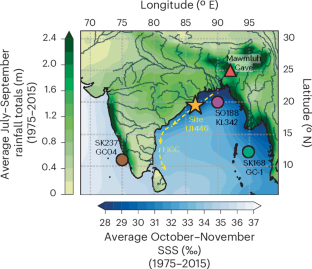2025-04-29 アリゾナ大学
<関連情報>
- https://science.arizona.edu/news/extreme-monsoon-variability-could-undermine-bay-bengals-role-global-food-source
- https://www.nature.com/articles/s41561-025-01684-6
インドの夏のモンスーンの異常な状態が、最後の氷河期を通じてベンガル湾の生産性を抑制した Extreme Indian summer monsoon states stifled Bay of Bengal productivity across the last deglaciation
K. Thirumalai,S. C. Clemens,Y. Rosenthal,S. Conde,K. Bu,S. Desprat,M. Erb,L. Vetter,M. Franks,J. Cheng,L. Li,Z. Liu,L. P. Zhou,L. Giosan,A. Singh &V. Mishra
Nature Geoscience Published:28 April 2025
DOI:https://doi.org/10.1038/s41561-025-01684-6

Abstract
Indian summer monsoon (ISM) hydrology fuels biogeochemical cycling across South Asia and the Indian Ocean, exerting a first-order control on food security in Earth’s most densely populated areas. Although the ISM is projected to intensify under continued greenhouse forcing, substantial uncertainty surrounds anticipating its impacts on future Indian Ocean stratification and primary production—processes key to the health of already-declining fisheries in the region. Here we present century-scale records of ISM runoff variability and marine biogeochemical impacts in the Bay of Bengal (BoB) since the Last Glacial Maximum (∼21 thousand years ago (ka)). These records reveal extreme monsoon states relative to modern strength, with weakest ISM intensity during Heinrich Stadial 1 (∼17.5–15.5 ka) and strongest during the early Holocene (∼10.5–9.5 ka). Counterintuitively, we find that BoB productivity collapsed during both extreme states of peak monsoon excess and deficits—both due to upper-ocean stratification. Our findings point to the possibility of future declines in BoB primary productivity under a strengthening and more variable ISM regime.



